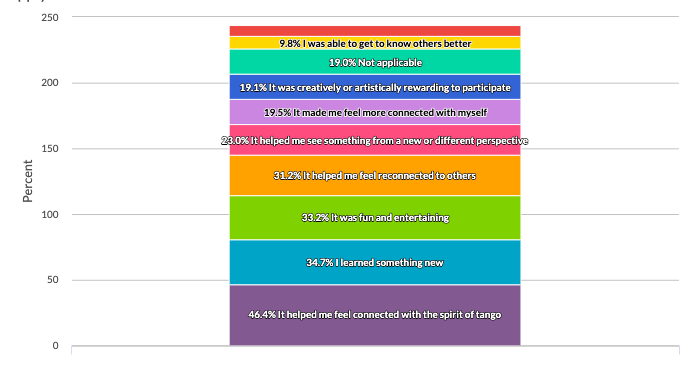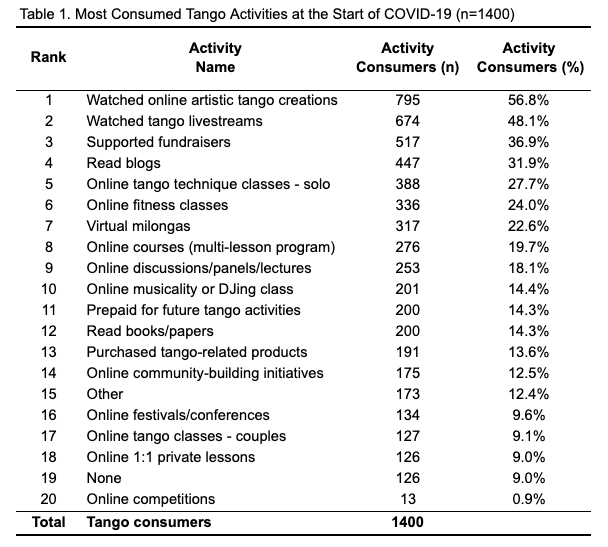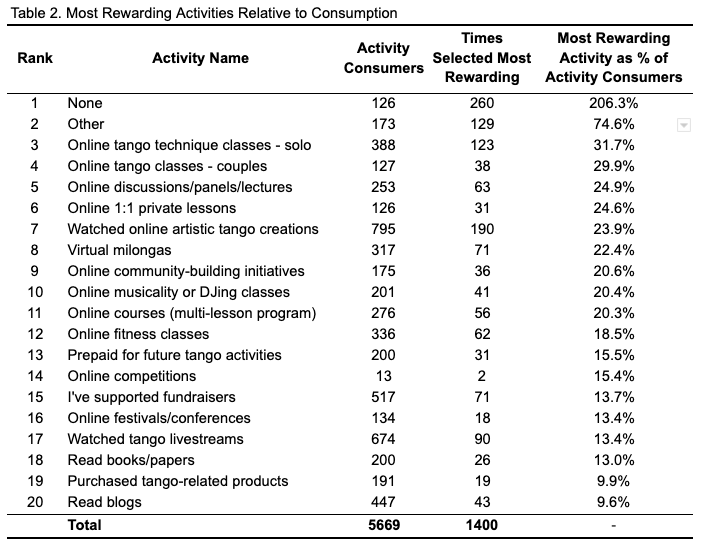Because of COVID, tango teachers and community organizers have begun offering online experiences. We wanted to find out what could be learned about how these were being experienced by participants. This analysis is drawn from data gathered during late May/early June 2020.
How popular and rewarding are online tango activities?
Data analysis contributed by Lissandra Ellyne
The following is drawn from our analysis of 1400 completed surveys. The five most consumed tango activities were online tango artistic creations (1), tango livestreams (2), fundraisers (3), tango blogs (4), and online solo tango technique classes (5). Only 9% (n=126) of these respondents reported not having done any tango related activities since the start of the pandemic to the time of taking the survey. Table 1 below displays all 19 of the tango related activities we asked respondents about, ranked in order of the proportion of respondents that reported having consumed the activity.
Even more interesting than how many respondents consumed a tango related activity since the onset of the pandemic is how often respondents considered the activity to be more rewarding than any of the other tango activities consumed. Table 2 provides a relative ranking of the survey’s 19 tango related activities from most to least rewarding activities based on the percent of activity consumers that also said the activity was most rewarding. Compared to absolute rankings, relative rankings are unaffected by activity popularity. Consequently, they provide a more accurate indication of activity rewards regardless of how many people consumed them.
There are several general findings from Table 2 that warrant some discussion. Firstly, the rewardingness rank of the top two activities, ‘none’ and ‘other’, must be interpreted with caution and differently from the remaining 18 tango related activities. In addition, to the 126 respondents who selected no activity was most rewarding because they had not consumed any tango related activities, 134 respondents (260-126=134), about 9.6% of total respondents, said that none of the activities they had consumed was most rewarding. In other words, a small percentage of respondents did not have a preferred activity at the time of the survey because they either found all or none of the activities they consumed to be equally rewarding or unrewarding.
Like the ‘none’ category rank, the ‘other’ activity rank is tricky to interpret without creating new activity categories to adequately reclassify the 173 ‘other’ activities consumed as well as the 129 ‘other’ activities respondents said were most rewarding. As a result, for the time being, all that can really be concluded about the 76% of respondents who appear to have consumed tango related activities outside of the suvey’s 18 categories and considered them to be most rewarding is that uniqueness or personalization may substantially increase activity rewards but we can’t really know until the survey’s activity list is broadened and other responses can be properly reclassified.
Secondly, online solo technique classes are also relatively frequently consumed and, among those who consume them, frequently enjoyed. Among the 123 people who chose solo technique classes as their most rewarding activity:
-
71% were women; 27% were men; 2% were nonbinary
-
54% were followers; 22% were leaders
Thirdly, online artistic tango creations — art, music, dance, comedy — clearly stand out as both frequently consumed (795 respondent) and also frequently enjoyed (24%). It remains to be seen how the production of this art might best be supported.
Lastly, the three top ranking activities (rank 4-6) after online solo technique classes, although consumed less often than other activities, stand out as being potentially as rewarding as top rated solo technique classes:
-
30% of consumers of online couples classes said it was the most rewarding activity
-
25% of consumers of online discussions/panels/lectures said it was the most rewarding activity
-
25% of consumers of online 1:1 private lessons said it was the most rewarding activity
These were not consumed as frequently, but those who did participate in them were more likely to rate them as the most rewarding thing they did, compared with other activities. Members of the tango community may want to explore these formats if they have not done so already.
Why were these activities rewarding?
Qualitative data coding and analysis contributed by Michael Luchtan
Considering the activities that participants found most rewarding, we explored why they were rewarding. Six main categories of benefits emerged:
Maintain technique
While some people were able to improve themselves during the confinement, a larger percentage of them were more concerned with not sliding back, with maintaining their technique. People had worked hard to be good dancers, and no one wanted to lose the tacit knowledge of how to move. People described this loss, this sense of physical forgetfulness, of feeling the tacit knowledge leave their body.
Improve technique
Related to this, although different and experienced by less people, was the ability to improve technique, the opportunity for self-improvement. This was available to some, but not to everyone. Some lucky ones lived with a dance partner. Others were too distracted living with family, too depressed living alone, or the online offering not sufficient to apprehend new material and the most they could hope is to not go backwards.
Maximizing the opportunity to improve technique was cited most often by musicians, who had time to work on technique and self-study. On-line “drills” were seen as the most successful for this.
Improve appreciation for tango
If people could not dance, could not improve their technique or even maintain it, many worked on furthering their appreciation of tango by exposing themselves to other aspects of tango culture. Online, they found many ways to better their understanding of tango: watching videos and listening to the music; learning more about the music and dance history and the different orchestras; tango podcasts; reading tango blogs. These various modalities gave individuals a better appreciation and allowed them to maintain a connection to the thing that they loved, even if it was not dancing.
Stay physical
There were various levels of quarantine around the world. While some people were allowed to take socially distanced walks or to ride a bike around the neighborhood, others were essentially locked in a box. People looked online to help fight the sedimentary nature of confinement, seeking group connection through classes. Many of these online activities were not directly related to tango, but still helped the respondents remain physical. Yoga, pilates, and other classes helped people feel physical by moving around, even if it didn’t help them with their tango.
Maintain connection to tango friends
The need and longing for a connection to tango friends was just as compelling, just as missed, as the dance itself among most participants. This aspect of tango was most fulfilled through online offerings. Just sharing an event, even in a Zoom meeting or a virtual milonga, the appearance of sharing the same time and space with someone, helped to maintain that connection with tango friends. People enjoyed the online offering because it let them stay connected to the tango friends who had up to the confinement been such a large part of their lives. Interestingly, this exposure to tango friends outside of a tango context seems to have deepened the feeling of community and friendship in a number of people.
One reason why people enjoyed connecting was that it allowed them to alleviate feelings of loss through commiseration, sharing in the misery and grief of confinement and enforced absence of tango.
Connect with global instructors
Perhaps the most prominent upside to the move to virtual, despite all its drawbacks, is that it has allowed for the individual student to access accomplished instructors from across the globe, regardless of where they might have been confined. This points to the main benefit that emerged from the forced move to online for tango activities. It goes without saying that the internet opens you up to a world of information and instruction from all over the globe. But this aspect has been overlooked in dance and other tacit, embodied knowledge based practices. The confinement has shown that it can be done, and the shift to virtual instruction has increased the number of skilled instructors one can choose to learn from.
The opportunity to give monetary support
This was considered rewarding for a number of reasons, the most obvious being the joy of giving. Generally, people felt obliged to support their teachers, their resident artists or schools because they (the teachers, artists, schools) had already given so much of themselves. When someone gives their all to tango, clearly they do not get it all back. They give excess love, energy and support. Those of us who benefit from that extra love, energy, and support, were able to now give the monetary support to those as a token of gratitude for the sacrifices, for what had been given to them.
The spirit of tango
Here is an overview of all participants’ responses to the question, “Why was it rewarding?”

Rewarding experiences fostered learning new things, fun, and reconnection.
Beyond that, it strikes me that when a person had a rewarding experience online, almost half the time they were likely to find it rewarding because the experience helped them feel connected with the spirit of tango. Perhaps the most valuable work we can be doing now is to explore the feeling of “being connected with the spirit of tango” and develop ways of facilitating that connection in the purest and most distilled ways that are possible given the new constraints.
Finally, it’s important to bear in mind that this data was gathered fairly early in the global tango pivot to online offerings. In the months since the survey closed, for it’s likely there have been further innovations and refinements. It will interesting to see how this space continues to evolve.

